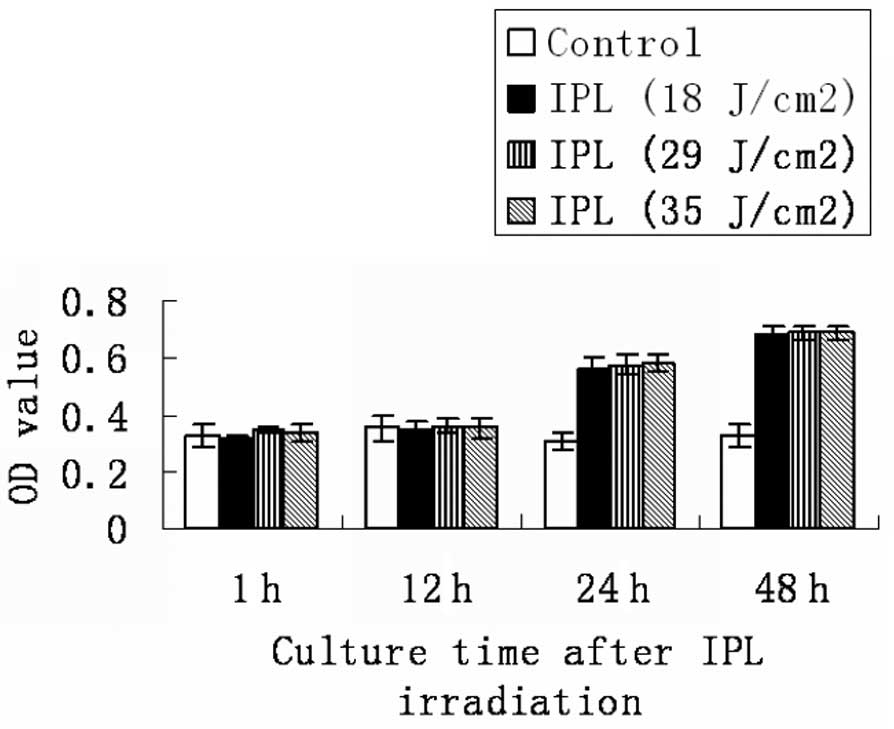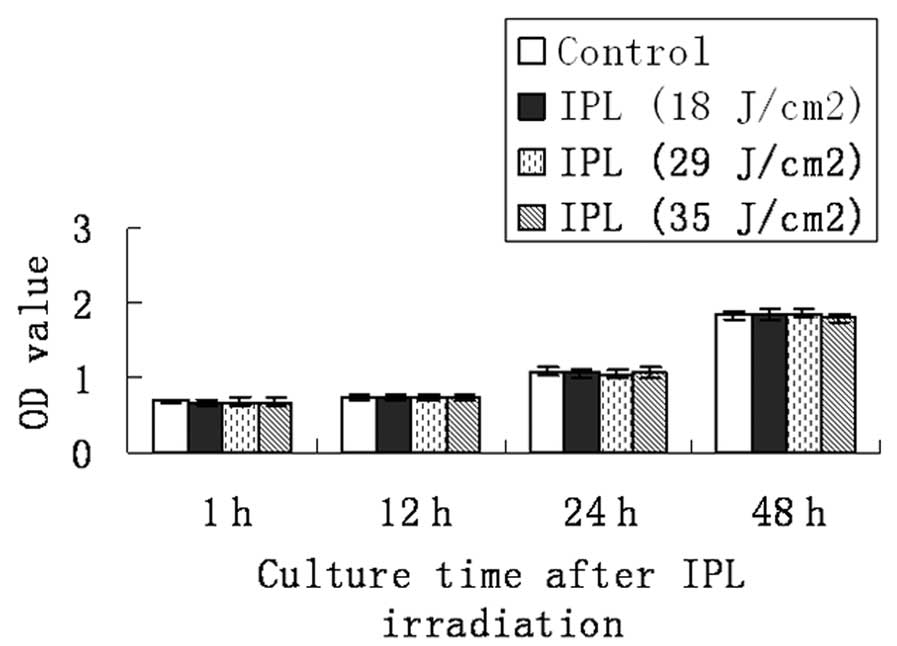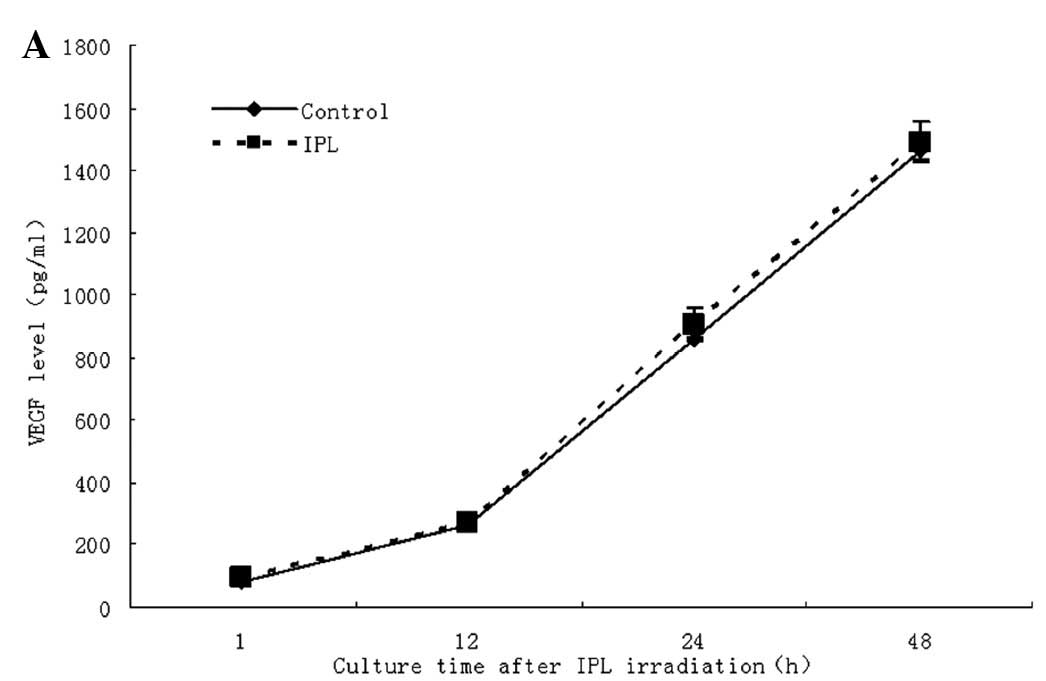Impact of intense pulsed light irradiation on cultured primary fibroblasts and a vascular endothelial cell line
- Authors:
- Di Wu
- Bingrong Zhou
- Yang Xu
- Zhiqiang Yin
- Dan Luo
View Affiliations
Affiliations: Department of Dermatology, The First Affiliated Hospital, Nanjing Medical University, Nanjing, Jiangsu 210029, P.R. China
- Published online on: August 14, 2012 https://doi.org/10.3892/etm.2012.664
-
Pages:
669-674
Metrics: Total
Views: 0 (Spandidos Publications: | PMC Statistics: )
Metrics: Total PDF Downloads: 0 (Spandidos Publications: | PMC Statistics: )
This article is mentioned in:
Abstract
The aim of this study was to determine the effects of intense pulsed light (IPL) on cell proliferation and the secretion of vascular endothelial growth factor (VEGF) and matrix metalloproteinases (MMPs) in human fibroblasts and vascular endothelial cell lines, and to investigate the effects of IPL on the mRNA expression levels of type I and III procollagens in cultured human fibroblasts. Foreskin fibroblasts and a vascular endothelial cell line (ECV034) were cultured and treated with various wavelengths and doses of IPL irradiation. After culture for 1, 12, 24 and 48 h following IPL irradiation, fibroblasts and the vascular endothelial cell line were harvested for investigation of morphological changes by light microscopy, cell proliferation viability by MTT assay, and VEGF and MMP secretions by ELISA. The mRNA expression levels of type I and III procollagens in the fibroblasts were detected by RT-PCR. No marked morphological changes were observed in the cultured fibroblasts compared with the control. Cell growth and cellular viability were increased in fibroblasts 24 and 48 h after IPL irradiation. The levels of type I and III procollagen mRNA expression in fibroblasts increased in a time-dependent manner. However, the IPL management had no impact on VEGF and MMP secretion levels in fibroblasts and the ECV034 cell line at any time-point after irradiation as well as cell morphology and cellular proliferation. IPL irradiation may induce cellular proliferation and promote the expression of procollagen mRNAs directly in cultured primary fibroblasts, which may primarily contribute to photorejuvenation.
View References
|
1
|
Berneburg M, Plettenberg H and Krutmann J:
Photoaging of human skin. Photodermatol Photoimmunol Photomed.
16:239–244. 2000. View Article : Google Scholar
|
|
2
|
Ohnishi Y, Tajima S, Akiyama M, Ishibashi
A, Kobayashi R and Horii I: Expression of elastin-related proteins
and matrix metalloproteinases in actinic elastosis of sun-damaged
skin. Arch Dermatol Res. 292:27–31. 2000. View Article : Google Scholar : PubMed/NCBI
|
|
3
|
Ouchi N, Shibata R and Walsh K:
AMP-activated protein kinase signaling stimulates VEGF expression
and angiogenesis in skeletal muscle. Circ Res. 96:838–846. 2005.
View Article : Google Scholar : PubMed/NCBI
|
|
4
|
Bitter PH: Noninvasive rejuvenation of
photodamaged skin using serial, full-face intense pulsed light
treatments. Dermatol Surg. 26:835–843. 2000. View Article : Google Scholar : PubMed/NCBI
|
|
5
|
Holck DE and Ng JD: Facial skin
rejuvenation. Curr Opin Ophthalmol. 14:246–252. 2003. View Article : Google Scholar
|
|
6
|
Negishi K, Tezuka Y, Kushikata N and
Wakamatsu S: Photorejuvenation for Asian skin by intense pulsed
light. Dermatol Surg. 27:627–632. 2001.PubMed/NCBI
|
|
7
|
Negishi K, Wakamatsu S, Kushikata N,
Tezuka Y, Kotani Y and Shiba K: Full-face photorejuvenation of
photodamaged skin by intense pulsed light with integrated contact
cooling: initial experiences in Asian patients. Lasers Surg Med.
30:298–305. 2002. View Article : Google Scholar : PubMed/NCBI
|
|
8
|
Angermeier MC: Treatment of facial
vascular lesions with intense pulsed light. J Cutan Laser Ther.
1:95–100. 1999. View Article : Google Scholar : PubMed/NCBI
|
|
9
|
Campolmi P, Bonan P, Cannarozzo G,
Bruscino N, Troiano M, Prignano F and Lotti T: Intense pulsed light
in the treatment of non-aesthetic facial and neck vascular lesions:
report of 85 cases. J Eur Acad Dermatol Venereol. 25:68–73. 2011.
View Article : Google Scholar : PubMed/NCBI
|
|
10
|
Fodor L, Peled IJ, Rissin Y, Ramon Y,
Shoshani O, Eldor L, Gaiman A and Ullmann Y: Using intense pulsed
light for cosmetic purposes: our experience. Plast Reconstr Surg.
113:1789–1795. 2004. View Article : Google Scholar : PubMed/NCBI
|
|
11
|
Talwar HS, Griffiths CE, Fisher GJ,
Hamilton TA and Voorhees JJ: Reduced type I and type III
procollagens in photodamaged adult human skin. J Invest Dermatol.
105:285–290. 1995. View Article : Google Scholar : PubMed/NCBI
|
|
12
|
Gale NW and Yancopoulos GD: Growth factors
acting via endothelial cell-specific receptor tyrosine kinases:
VEGFs, angiopoietins, and ephrins in vascular development. Genes
Dev. 13:1055–1066. 1999. View Article : Google Scholar : PubMed/NCBI
|
|
13
|
Bramono DS, Richmond JC, Weitzel PP,
Kaplan DL and Altman GH: Matrix metalloproteinases and their
clinical applications in orthopaedics. Clin Orthop Relat Res.
428:272–285. 2004. View Article : Google Scholar : PubMed/NCBI
|
|
14
|
Hornebeck W: Down-regulation of tissue
inhibitor of matrix metalloprotease-1 (TIMP-1) in aged human skin
contributes to matrix degradation and impaired cell growth and
survival. Pathol Biol (Paris). 51:569–573. 2003. View Article : Google Scholar : PubMed/NCBI
|














